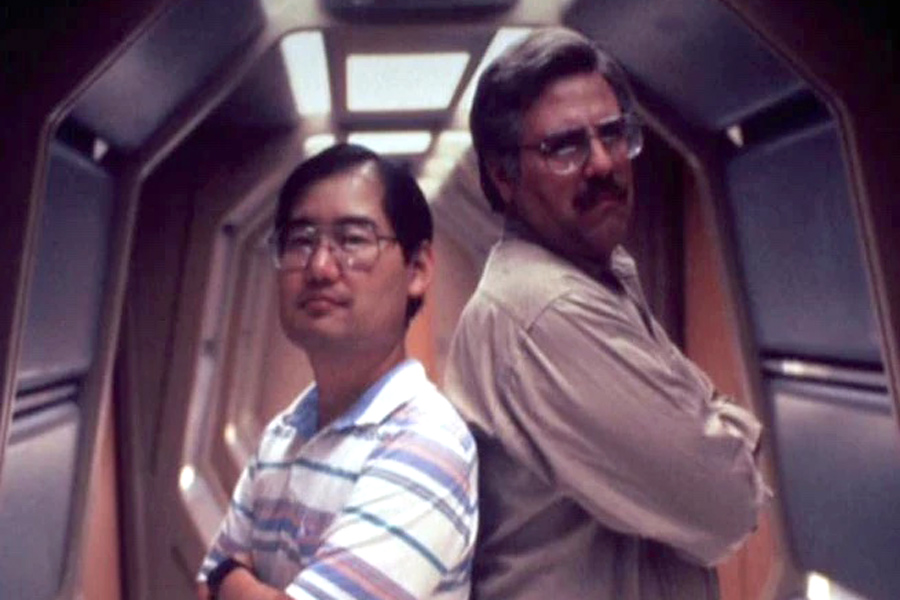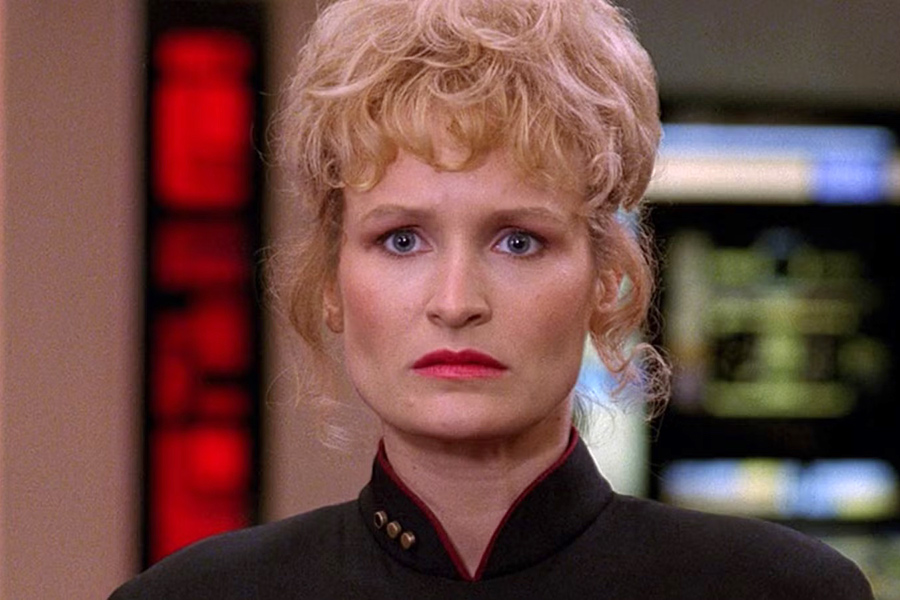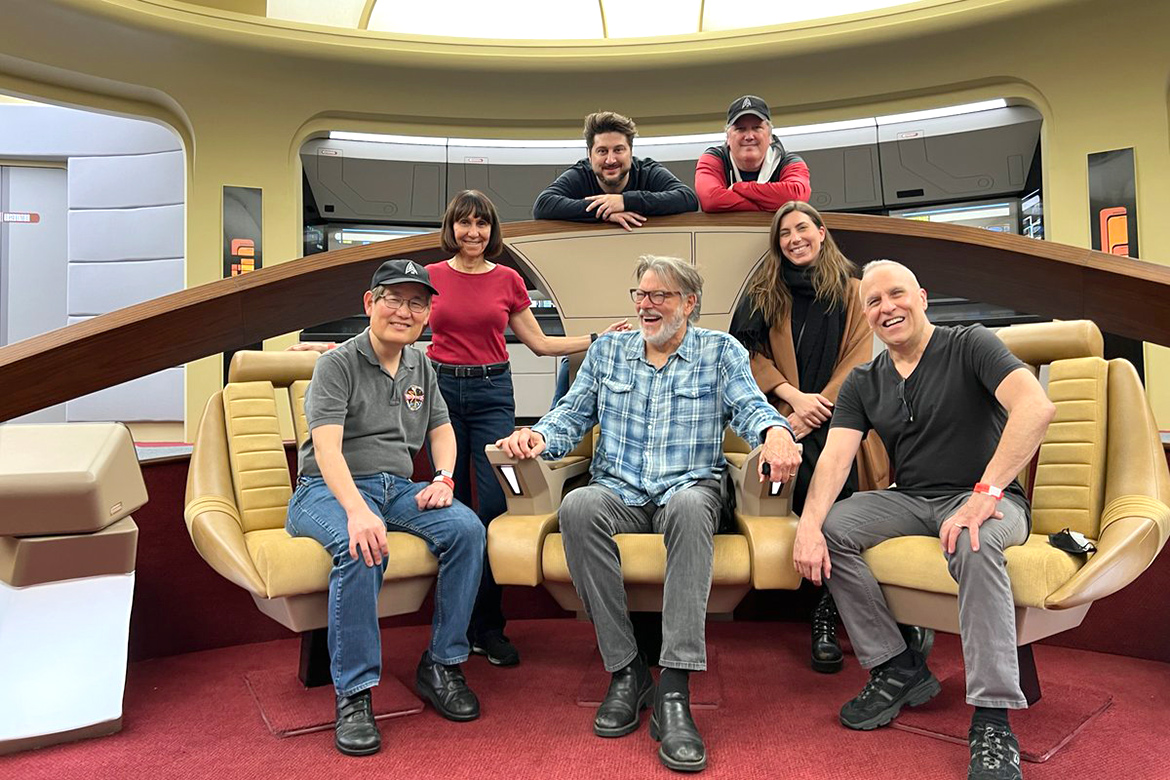Star Trek: The Next Generation’s Michael Okuda had very little time to help make TV history.
While working as graphics designer on the Star Trek franchise’s first cliffhanger — the famous, Borg-centric season three finale “The Best of Both Worlds, Part I” — Okuda and his team worked diligently to ensure that then-complex video graphics and alien set signage were ready in time for the ambitious episode’s airdate: June 18, 1990.
"We were always aware that this was going to be a special episode," Okuda tells the Television Academy. "It was a season cliffhanger, and the Borg were already popular. You got the sense among the cast and crew during production that this episode was going to work."
Written by TNG’s showrunner and executive producer, the late Michael Piller, “Best of Both Worlds” brought back the Borg from season two’s “Q Who?” episode and set the cybernetic, assimilation-happy villains on a course to invade Earth as Captain Picard (Sir Patrick Stewart) and the crew of the Enterprise-D struggle to stop them.
 Locutus of Borg (Sir Patrick Stewart) reveals himself to the Enterprise / Photo by: CBS/Paramount
Locutus of Borg (Sir Patrick Stewart) reveals himself to the Enterprise / Photo by: CBS/Paramount
In between space battles with the Borg’s cube-shaped vessel, the drama shifts to the Enterprise where there is a clash of command styles between veteran first officer William Riker (Jonathan Frakes) and the young and forceful Borg tactical expert Lt. Cmdr. Shelby (Elizabeth Dennehy). The latter wants Riker’s job as the former debates why he’s passed up a third opportunity to command a ship of his own. Riker’s reluctance to take “the big chair” is put to the test when he is forced to take command of the Enterprise after Picard is abducted by the Borg and turned into a being known as Locutus. The cliffhanger culminates with Picard assimilated into the ranks of his most lethal enemy as Riker gives an ominous order to fire a potentially fatal weapon at his former captain.
Once fans lifted their jaws off their living room floors, they would spend the rest of summer 1990 chatting around the watercooler about the fate of one of their favorite captains. Was Picard dead? Would he ever come back to the show? Was there even a show to come back to?
Fandom’s musings about the future of The Next Generation sparked national news coverage, which in turn propelled TNG into a new level of popularity that forever changed Star Trek. It also inspired other sci-fi shows, like Fox’s The X-Files, to lean into the big ratings that season-ending cliffhangers could bring.
Piller’s bold narrative choice would have a ripple effect across creator Gene Roddenberry’s franchise, the repercussions of which would be further explored in the 1996 feature film Star Trek: First Contact (directed by Frakes) and in 2023’s third and final season of Star Trek: Picard. It also provided Okuda, who would work on various Trek series from 1993–2005, with one of his most demanding workloads.
"We had more pre-production time on ‘Q Who?’ than we had on ‘Best of Both Worlds,’ because [‘Q Who’] was deliberately going to introduce this new group of adversaries," Okuda explains. "But [with ‘Best of Both Worlds’], it was not a large amount of prep time."
 Okuda (left) and Sternbach on the TNG set / Photo by: Paramount
Okuda (left) and Sternbach on the TNG set / Photo by: Paramount
Armed with only an early story outline from Piller, Okuda and fellow designer and illustrator Rick Sternbach were given their brief: "Look for various tech hooks for certain scenes." Meaning, find moments in the story that require interesting visual graphics and design elements and execute them. Piller especially wanted the team to revisit and update two key sets: The stark interior of the Borg cube from "Q Who?" and the Enterprise’s battle bridge — which appears in season four’s premiere episode, "The Best of Both Worlds, Part II."
In addition to creating both static and video graphics for the battle bridge, Okuda also had the job of being the writing staff’s technical advisor. It was in that capacity where Okuda made one of his most significant contributions to Trek lore.
“Piller hadn't decided what he wanted Shelby's role to be," Okuda recalls. "He knew he wanted her as a foil for Riker, but her actual job was up in the air. And I remember sending a note saying, 'Given the story’s circumstances, perhaps she should be a tactical advisor whose job is to figure out how to fight the Borg.' That was my pitch."
Piller would also frequently tap Okuda and Sternbach for their expertise when it came to the sci-fi side of things, as the late showrunner considered himself more of a drama writer than a science-fiction one.
 Okuda helped shape the pivotal character of Lt. Cmdr. Shelby / Photo by: CBS/Paramount
Okuda helped shape the pivotal character of Lt. Cmdr. Shelby / Photo by: CBS/Paramount
"He was an excellent dramatist. He understood how to make characters work. So he leaned on people like myself and Sternbach to help shape the technology. He would frequently call us and say, 'Okay, here's what happens [in the story]. Here's what happens from a character point of view in a scene. Suggest to me what they could be doing that's technically credible for that story situation, then tell me what goes wrong and then tell me how they fix it.' Michael Piller was remarkable in that he would accept pitches from basically anyone."
What was also remarkable was how Okuda designed and executed computer graphic animations that were supposed to originate from the 24th century using some very "old school" 20th century tech.
"The design process was a very deliberate and exacting one at the time," Okuda says, especially in regards to new tactical displays via video screens on the battle bridge that depicted a spinning section of the Enterprise’s stardrive section. (The part that isn’t the big saucer where the Captain and crew usually sit.) A mix of custom physical models and wireframe computer graphics were often used to represent the spinning ship section’s animation, which would play on a loop on monitors via videotape live on set. According to Okuda, computer graphics and 24-frame video playback were largely not used at the time, due to time and cost. But a season finale’s budget could afford the indulgence.
"When I came to work on Next Gen," Okuda says, "I assumed most of our graphics would be video playback — much as they had done on the Star Trek films. The problem was ... playback wasn't cheap. You rented the monitors, you rented the playback machines, you had to pay to have [the animation] transferred to 24 frames — even if the animation was generated in-house. So, it was considerable logistics. Most of the time on Next Generation, whenever there was video, it was likely because I foolishly would stand up in the production meeting and say, 'Why don't we have video here? Let me do it.' So I was the de facto video coordinator for playback graphics. I literally did acetate animation cels and had an outside vendor photograph it on 35mm film, then transfer it to video, then standards converted it to 24 frame. Needless to say, it was cumbersome."
 Okuda with his wife, Denise, and cast and crew on the set of Star Trek: Picard / Photo by: Michael Okuda
Okuda with his wife, Denise, and cast and crew on the set of Star Trek: Picard / Photo by: Michael Okuda
"Cumbersome" seems like an understatement when Okuda reveals the process required to put his animated graphics onto videotape. (Trigger warning ahead for L.A. drivers who dread traveling to the Valley.)
When the production let Okuda purchase a then–top-of-the-line Macintosh II during the second season to make color graphics, he would have to take his entire computer with him from his office at Paramount in Hollywood to Burbank, where the show’s vendor, Warner Bros. Production Sound, would then convert his work into their proprietary 24-frame format on 3/4-inch videocassette. And then Okuda would drive it back to Paramount for the production to play the video during filming. (For that amount of arduous drive time, it’s too bad the transporter room isn’t real.)
Despite the mileage put on his car, and the hours spent hunched over the precursor to Star Trek’s supercomputers, it proved to be more than worth it for Okuda when he saw the final product on the night "Best of Both Worlds" premiered.
"We had a viewing party at Piller's house. Michael invited a bunch of people over to his house to watch. Gene was there, surprisingly. It wasn't that large a group; I think some cast members were there. But he also invited us from the art department, and he invited some of the extras and stand-ins, which I thought was such a lovely thing for him to do."
It was at that viewing party where all of the production’s hard work to make the iconic episode began to crystalize for Okuda, as well as Piller's contribution at large, to a franchise that will soon turn 60.
"Next Generation did have a rocky start. Roddenberry had a great initial idea [for the show], and it took a lot of guts to do what Roddenberry did. But Piller was a guy who made it work."
Star Trek: The Next Generation is streaming now on Paramount+.












